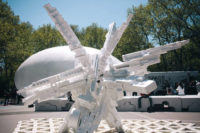Tyrolean Festival Hall
Peak Performance: A concert hall carves its own niche in the Austrian Alps while bowing to the neighboring midcentury playhouse and the breathtaking landscape beyond.
















Architects & Firms
Erl, Austria
In the picturesque Austrian village of Erl, just east of the German border, where the rugged Alps seem to descend from the heavens to meet the undulating valley below, a striking, angular structure, the Tyrolean Festspielhaus, or Festival Hall, pierces the landscape that inspired it. “We conceived of the building as tectonic plates shifting over one another,” says Sebastian Brunke, one of the project architects (along with Jörg Rasmussen), of the Viennese firm Delugan Meissl Associated Architects (DMAA). “The opening between the two plates forms the foyer, which glows at night and through which the Alpine landscape flows like a carpet.” Reflecting the mountains above, the upper volume's sharply pointed cantilever juts out almost 100 feet. Its radical design juts out, too, in Erl–a typical Tyrolean town of traditional wood chalets with flowerboxes full of geraniums.
The new concert hall, with its horizontal orientation and stern, thrusting forms, is also a counterpoint to its predecessor, the adjacent Passionsspielhaus, or Passion Playhouse, a swooping white performance space by Tyrolean architect Robert Schuller. Built in the late 1950s to host a Passion play once every six years (a local tradition that dates back to the early 17th century), the uninsulated, nautiluslike building is only able to operate during the warmer months. Thanks to the new venue, the Tyrolean Festival organization, with its own orchestra and choir academy, is now able to extend its program of opera and classical music into the winter.
“In order to wrap a volume like this, with its two intersecting planes,” explains the 33-year-old Brunke, “we broke the envelope down into elements whose pattern does not have a discernable direction.” Lending a reptilian texture to the sleek, origami-like form, a skin of charcoal-colored fiber cement panels shrouds the building and takes on various shades of black and gray depending on the angle of the sun. The surface is composed of modules, each consisting of four panels—two chevron-shaped pieces and two irregular quadrilaterals—mounted on metal frames secured to the building's steel structure as if part of an elaborate jigsaw puzzle.
The influence of the Alpine topography continues past the concert hall's sculptural exterior. Inside, the double-height foyer narrows and widens, reflecting the nature of the site in its 3 percent slope up from west to east. Traversing the building means feeling the sensation of moving up or down that gradient. This is emblematic of the architects' larger design approach, where expanding and contracting spaces guide visitors through their buildings, causing them to experience the dimensions of the architecture in a more conscious way. The lobby's acutely angled walls mirror the dark facades beyond, as well as to the surrounding mountainous landscape, which seeps in through strategic slashes in the walls. Inserted into this public space are a bar, cloakroom, and ticket counter whose darkly hued interiors contrast with the bright white of the lobby.
Beyond the foyer, visitors enter the 732-seat concert hall, the heart of the building. The space is relatively square; the architects altered the original competition-winning design, which was longer and narrower, to cut costs by minimizing excavation into the hillside behind. Even so, a massive quantity of stone and soil had to be removed to anchor the building in the slope. Adjusting the concert hall's proportions also brings the audience closer to the stage, creating a more intimate experience. This “folded cave,” as Brunke describes the hall, is lined in oiled acacia panels installed with impeccable workmanship. Flexibility was key to the design. The orchestra pit can be raised mechanically to the same level as the front of the hall, making it possible to add 130 chairs. And it can be raised farther, to the level of the stage, to hold a full orchestra. Movable wood panels in the wings can alter the width of the stage from 59 to 69 feet, to accommodate anything from chamber music to opera. Offices, rehearsal areas, and dressing rooms are tucked into the irregular “leftover” spaces between the rectangular hall and the assertive facade.
From the point when DMAA won the competition for the project in 2007, progress was swift. It helped that the firm had the trust of the Festival president, Hans Peter Haselsteiner, who is an art collector as well as executive of the project's construction company and its main financier. Construction started in the fall of 2010, and the 95,000-square-foot building was complete in less than 20 months.
The greatest challenge of the project, says Brunke, was to accommodate the specific programmatic demands for the building while maintaining the fluid geometry of its form. The architects also had their work cut out for them with regard to the site and its bold existing features, both built and natural. And here DMAA's instinct was dead on: rather than insert itself quietly onto the scene, the Festival Hall Erl translates the language of its surroundings into a powerful architectural gesture, marking a new era for the tradition of performance in this quaint Tyrolean enclave.
People
Owner:
Architect:
Personnel in architect's firm who should receive special credit: Interior designer: Delugan Meissl Associated Architects Engineer(s): FCP Fritsch, Chiari & Partner ZT GmbH, Vienna
Consultant(s): Acoustical: Quiring Consultants, Aldrans
Other:
General contractor:
Photographer(s): Renderer(s): Delugan Meissl Associated Architects Size: 95,000 square feet Cost: $47 million Completion date: August 2012 |
Products
Structural system
Exterior cladding
Other cladding unique to this project:
Roofing
Windows
Doors
Interior finishes
Cabinetwork and custom woodwork:
Wall coverings:
Foyer and offices: Cladding:
Paneling: (Concert hall):
Resilient flooring:
Furnishings
Lighting
Downlights:
Task lighting:
Exterior:
Dimming System or other lighting controls:
Conveyance
Energy
Add any additional building components or special equipment that made a significant contribution to this project:
Gunned concrete: |










